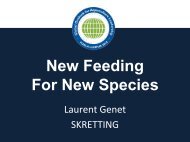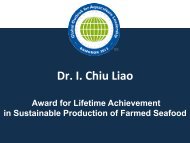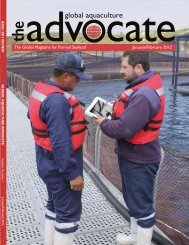May/June 2010 - Global Aquaculture Alliance
May/June 2010 - Global Aquaculture Alliance
May/June 2010 - Global Aquaculture Alliance
You also want an ePaper? Increase the reach of your titles
YUMPU automatically turns print PDFs into web optimized ePapers that Google loves.
Both wild and farmed salmon are healthful choices that<br />
are low in total fat and high in protein, vitamins, minerals<br />
and omega-3s. Photo courtesy of the California Salmon<br />
Council.<br />
• Mercury, PCBs<br />
Methylmercury, an organic form of mercury, and polychlorinated<br />
biphyenyls (PCBs) are not a health concern associated<br />
with eating farmed or wild salmon.<br />
Minute quantities of mercury are detectable in air, water,<br />
soil and all living matter. The Institute of Medicine reported<br />
that salmon, whether farmed or wild, is one of the species<br />
lowest in mercury levels and highest in omega-3 fatty acids. A<br />
2008 study by Barry Kelly and co-authors found mercury in all<br />
salmon samples ranged from 0.03 to 0.10 ppm. This was well<br />
below the action level of 1.0 ppm enforced by the U.S. Food<br />
and Drug Administration (FDA). Negligible differences in<br />
mercury concentrations were observed between the various<br />
species of farmed and wild salmon.<br />
Until the late 1970s, PCBs were manufactured globally<br />
and used in many electronic products. Health concerns about<br />
PCBs led to a ban on their use, and since then, the levels of<br />
PCBs in food products and the environment have declined<br />
significantly.<br />
Currently, over 90% of PCBs that remain in Americans’<br />
foods comes from sources other than seafood. PCB levels in<br />
farmed and wild salmon are low and generally range from 5 to<br />
60 ppb. This is less than 3.1% of the FDA tolerance level of<br />
2,000 ppb.<br />
• Antibiotics<br />
In the U.S., the FDA regulates antibiotics, which are used<br />
to treat ill farm-raised animals including fish, swine, cattle and<br />
chickens – except in certified organic animal culture. Veterinarians<br />
oversee the way antibiotics are used when they are needed.<br />
Farmers must follow U.S. Environmental Protection<br />
Agency and FDA regulations that monitor antibiotic use and<br />
environmental impacts. These regulations also make sure antibiotics<br />
are used for the shortest time possible, so residual<br />
traces do not go above the FDA level of concern.<br />
• Hormones<br />
No hormones are used in salmon farming or added to<br />
salmon diets. So, hormones are not a concern when eating<br />
farmed or wild salmon.<br />
Commercial<br />
Salmon Facts<br />
Atlantic salmon, Salmo salar, are more closely related to<br />
brown trout than to the Pacific salmon of the genus Onchorhynchus.<br />
Atlantic salmon have been domesticated and selectively<br />
bred for many generations. The primary species used<br />
in fish farming, they are grown in net pens in nearshore<br />
coastal waters and are typically harvested at a weight of 3.6<br />
to 4.5 kg and length of 71 to 76 cm.<br />
Greatly reduced populations of wild Atlantic salmon still<br />
spawn in rivers on both sides of the Atlantic. Although historically<br />
of great commercial importance, today less than 1% of<br />
commercially available Atlantic salmon come from the wild.<br />
Chinook salmon, Onchorhynchus tshawytscha, also known as<br />
king salmon, live from California, USA, to Japan, with<br />
successful new populations in the Great Lakes and New<br />
Zealand. Chinook is the largest and least abundant of the<br />
Pacific salmon species. Their average weight is about 9 kg,<br />
and they range from 76 to 100 cm in length. Small quantities<br />
of farmed Chinook salmon can be found in the marketplace.<br />
Sockeye salmon, Oncorhynchus nerka, also known as red<br />
salmon, are an important commercial species in British<br />
Columbia, Canada, and Alaska, USA. Their bright red<br />
flesh is prized for canning and for fresh and frozen products.<br />
The average size of fish in the market is approximately<br />
2.7 kg and 91 cm in length.<br />
Coho salmon, Oncorhynchus kisutch, also known as silver<br />
salmon, range from northern Baja California to Korea. The<br />
average weight is 4.5 kg, and they range from 63 to 89 cm<br />
in length. Only small quantities of coho salmon are<br />
farmed.<br />
Pink salmon, Onchorhynchus gorbuscha, are also known<br />
as humpback salmon because of the large hump males<br />
develop during spawning season. Pinks are the smallest<br />
but most abundant Pacific salmon, generally weighing<br />
0.9 to 1.4 kg at a length of 76 cm. They live from Puget<br />
Sound to Russia. Most pinks are canned and tend to<br />
cost less than other types of salmon.<br />
Chum salmon, Onchorhyncus keta, are also known as silverbright,<br />
keta or dog salmon. The average weight is 3.6 kg,<br />
and they can grow to 68 cm long. They are relatively easy<br />
to farm, and large hatchery programs in Japan and southeast<br />
Alaska complement wild populations. Chum are harvested<br />
commercially in large numbers when they return to<br />
their release sites. Like the pink salmon, chums tend to<br />
cost less than other types of salmon. They are sold canned,<br />
smoked, fresh and frozen.<br />
marketplace<br />
Bangladesh Seeks Export Markets<br />
For Striped Catfish<br />
Fish typically receive pelleted feed at larger farms. Smaller<br />
operators may use lower-quality feeds.<br />
Summary:<br />
Striped catfish have become an important fish for<br />
national food security in Bangladesh, especially for<br />
poor consumers. The catfish-farming industry in the<br />
country is dominated by relatively small-scale farms<br />
that produce fish primarily for local markets. Due to<br />
potential overproduction, large-scale producers will<br />
likely need to process and export about 25% of the<br />
current production to survive in the long term.<br />
Commercial farming of striped catfish, Pangasianodon hypophthalmus<br />
(Pangasius), introduced from Thailand started about<br />
1998 and expanded rapidly after 2000 in Mymensingh, Bangladesh.<br />
As production is almost entirely for the local domestic<br />
market, overproduction led to a recent market glut that<br />
depressed farm gate prices below production costs. For largescale<br />
producers to survive in the long term, there is a need to<br />
process and export about 25% of the current farmed production.<br />
Industry Structure<br />
According to the Fish Culturists Association of Bangladesh,<br />
there are about 3,500 commercial farms exceeding 1.2 ha in<br />
Mymensingh and many thousands more smaller-scale farms.<br />
About 70% of the commercial farms are less than 5 ha in<br />
area, 20% cover 5 to 10 ha, and only 10% are larger than 10 ha.<br />
Thus the industry is dominated by relatively small-scale farms,<br />
but only about 30% of the total production is of sufficiently high<br />
Dr. Peter Edwards<br />
Emeritus Professor and Consultant<br />
Asian Institute of Technology<br />
593 Lat Prao Soi 64<br />
Bangkok 10310, Thailand<br />
pedwards1943@gmail.com<br />
Md. Sazzad Hossain<br />
Director, Shushama Feed Ltd.<br />
Gulshan, Dhaka, Bangladesh<br />
quality for export. Most of the production is marketed locally at<br />
a relatively low price.<br />
Development<br />
When commercial farming of striped catfish started, the<br />
profit was very high, as the public initially confused the species<br />
with the scarce native catfish Pangasius pangasius, which today<br />
retails for U.S. $4-6/kg. In 1994, the production cost of striped<br />
catfish was only $0.44/kg compared to a farm gate price of<br />
$1.76/kg, which was a major factor in the initial expansion of<br />
catfish farming in the country. Unfortunately, attempts to<br />
develop commercial culture of the native river catfish have been<br />
unsuccessful to date.<br />
Total production of striped catfish reached 300,000 mt in<br />
2008, which caused a market glut. The farm gate prices fell to<br />
U.S. $0.66-0.68/kg – below the $0.74/kg cost of production –<br />
and about 30% of farmers stopped raising the fish. When the<br />
production in 2009 fell to 200,000-250,000 mt, the farm prices<br />
rose once more to a profitable $0.88-0.96/kg toward the end of<br />
2009.<br />
Local Benefits<br />
Striped catfish have become an important fish for national<br />
food security, especially for poor consumers because of its relatively<br />
low price compared to the major Indian carp rohu, Labeo<br />
rohita, which retails for about twice as much. Rohu grow well<br />
only in large ponds and take a much longer two years to attain a<br />
marketable size of 1.5 kg.<br />
Relatively poor farmers get in and out of striped catfish farming,<br />
reverting back to rice farming depending on the profitability<br />
of the fish and rice. Poor rice farmers who are unable or unwilling<br />
to farm fish can benefit from leasing or selling their land to<br />
fish farmers or be employed at large fish farms, which require<br />
several full-time workers per ha.<br />
Farming System<br />
The catfish ponds are shallow with a depth of only 1.5 m. As<br />
they are constructed in low-lying rice land, they could not be deeper<br />
since draining would not be possible. Large commercial farms are<br />
filled with groundwater pumped from 100-m-deep tube wells.<br />
Although there are no government regulations concerning<br />
the use of groundwater, its level has remained unchanged after<br />
more than a decade’s pumping. One-third of the pond water<br />
64 <strong>May</strong>/<strong>June</strong> <strong>2010</strong> global aquaculture advocate global aquaculture advocate <strong>May</strong>/<strong>June</strong> <strong>2010</strong> 65





